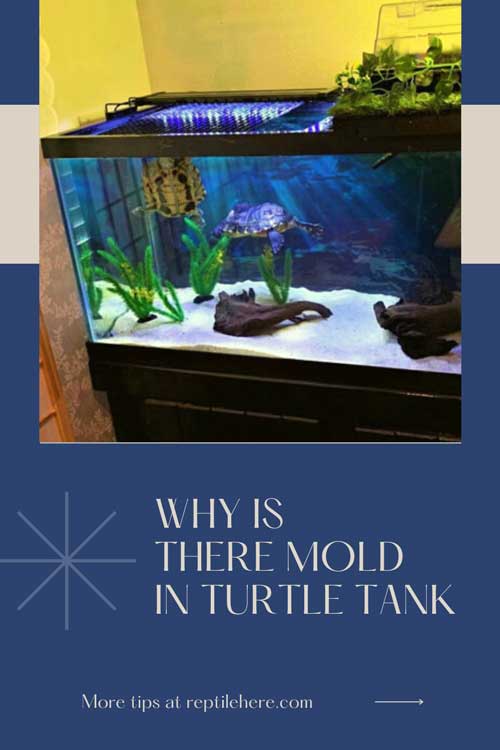Why Is There Mold In Turtle Tank: How To Get Rid Of It?
If you have just discovered mold in your turtle tank, you could be having many questions running through your mind. You may be asking yourself where the mold in the tank came from and how you can get rid of it. This guide will provide you with all the information you seek.
Why is there mold in your turtle tank? Mold in your turtle tank is usually caused by external sources such as contaminated rocks and plants that you introduce to your tank. Dirty tank water and nutrient imbalance in tank water due to inadequate filtration or overfeeding can also cause black mold
Read the following post to discover more in-depth info about mold in turtle tanks including where it comes from, whether it’s deadly to your pet turtles, various methods you can apply to get rid of it and prevent it from forming again, and more.
What causes mold in turtle tank?
Contents
One of the most common causes of mold in your turtle habitat has something to do with external contaminated objects, e.g. rocks, decorations, and plant substrates, to name but a few.
These objects usually carry small particles of mold, especially if you pick them outdoors. If you put them in the tank, the small mold particle will quickly multiply and fill your entire tank with mold.
Why multiply in the tank? You may wonder…the truth is mold can grow on anything moist/wet and the humid environment of your turtle aquarium makes a prime real estate.
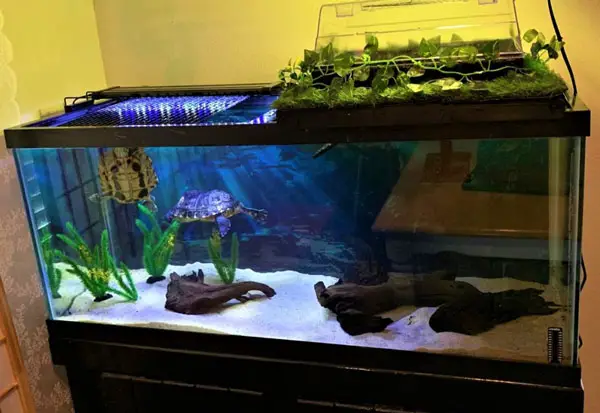
Another reason you have mold in your turtle tank is inadequate filtration. If you didn’t add any of the objects mentioned above in your tank and you still have modes, it could be due to a less powerful filtration system you’re using.
Turtles are generally messy eaters and will leave food particles inside the tank whenever you feed them. if not removed, these particles will start producing mold soon enough.
Even worse, your turtles excrete in these waters and if the excretes aren’t removed, they’ll help the mold grow even faster.
If you have a less powerful filter that won’t keep up with the turtle mess in your turtle tank, then the above things can’t be kept under control and will lead to a mold outbreak in your aquarium.
How to get rid of mold in turtle tank
The ultimate best way to get rid of mold in a turtle tank is to give your tank a thorough cleaning. it doesn’t matter how much mold has infested your tank, failing to clean the tank completely will always make it come back.
So, you should start by shifting your turtle to another clean container with water to enable you to clean your aquarium properly.
The best way to clean the tank is to boil all the parts that can be boiled; this does the trick when it comes to getting rid of mold. Though some folks recommend using cleaning chemicals to kill mold, we advise you to use as few chemicals as possible.
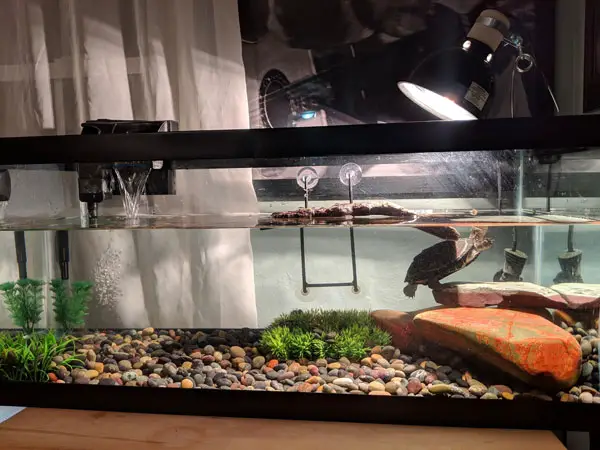
For the tank parts that can’t be boiled, e.g. the tank itself, consider washing it using hydrogen peroxide (this is a harmless compound that’s highly effective in getting rid of mold).
Afterward, be sure to thoroughly rinse the tank with warm water to get rid of hydrogen peroxide. This compound isn’t harmful to your turtles but can inhibit the growth of good bacteria.
DON’T forget to clean the water filter as well. You’re usually advised against cleaning the filter because it carries the good bacteria in plenty. But in this case, you’ll need to clean it as well to help completely get rid of mold.
Lastly, you’ll need to clean your pet turtle. If your tank has mold, chances are high that some of it have gotten on the turtle’s shell, and not getting rid of it will mean reintroducing mold in the tank after all the cleanup work. Just use a soft-bristled toothbrush and water to clean your turtle.
Other tips for getting rid of mold in turtle tank:
Add a UVB light to your tank
If you don’t have a UVB light already installed in your turtle tank, we also advise you to get one. UV light helps kills mold by sending out short wavelengths of electromagnetic radiation that penetrate mold and break up its DNA, thus inactivating it.
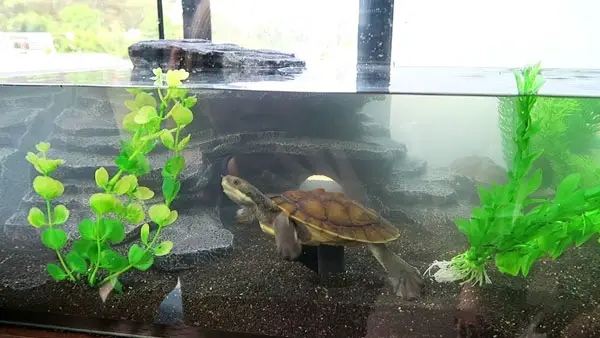
Increase the tank water temperature (heat treatment)
Increasing the water temperature inside your turtle tank (set the heater to 110°F to 120°F, for around an hour and a half) can also help get rid of the mold. As you may already know, mold thrives in a cool and damp environment. As such, raising the water temperature in the turtle tank will make the environment uncomfortable for it.
What if you have mold on the basking log?
If you’re dealing with mold on basking log, then you can treat it with a solution of billed water and vinegar and then allow it to dry completely in the sunshine for a few days. This will help completely get rid of the mold.
However, keep in mind that the mold might show up again as it feeds on the nutrients in the piece of wood.
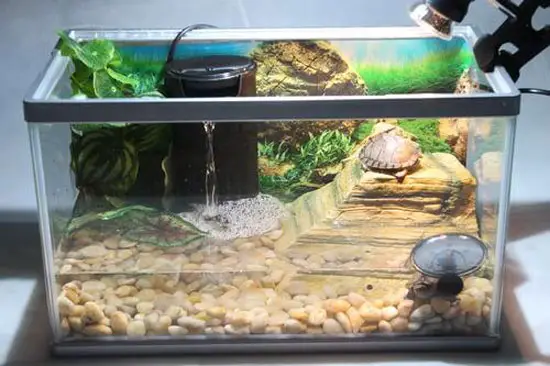
If the mold shows up again, you can use a toothbrush or a piece of metal with a sharp edge to scrape away the mold before it grows and takes over the entire piece of basking log.
How do you prevent aquarium mold?
Getting rid of mold in your turtle aquarium isn’t enough. You should also take the measures we’ve outlined below to ensure the mold doesn’t grow again in your tank.
Disinfect everything you put in the tank
The first step to ensure a mold free is to ensure you first disinfect anything you plan to add to your turtle enclosure.
You can do this by putting the object in a pot of boiling water for approx. 5 minutes.
You may also disinfect them with soap and other cleaning products. But be sure to rinse the objects thoroughly afterward to avoid introducing soap and other chemicals to your turtle tank.
And if you’re dealing with live plants which can’t be put in boiling water, consider getting your plants from pet stores.
Such plants are carefully grown in controlled mediums where no mold or harmful bacteria can get to them.
Get a more powerful filtration system
We have mentioned above that inadequate filtration can lead to mold growth in your turtle tank.
If you suspect this is the reason there’s mold in your turtle tank, you can try replacing your current filter with a more powerful system.
The rule of thumb when it comes to filters is to install a filter that has double the power that your tank requires.
For instance, if you have a 40-gallon tank, get an 80-gallon rated filter. if possible, you can get a filter with an even higher rating. This will help keep your tank clean for even longer.
But don’t go lower, else you’ll have inadequate filtration that will force you to clean your tank more often and even increase the chances of mold growth.
Is mold in turtle tank dangerous?
This will mainly depend on the type of mold. The white mold is generally not harmful to turtles. However, black mold is hazardous to your pet and can lead to various turtle diseases such as respiratory issues.
Not just turtles, black mold can also cause health issues in humans such as respiratory diseases. It can cause headaches, sneezing, and coughing in pet owners.
According to this 2004 study by Institute of Medicine, mold exposure has been linked to respiratory tract irritation in humans.
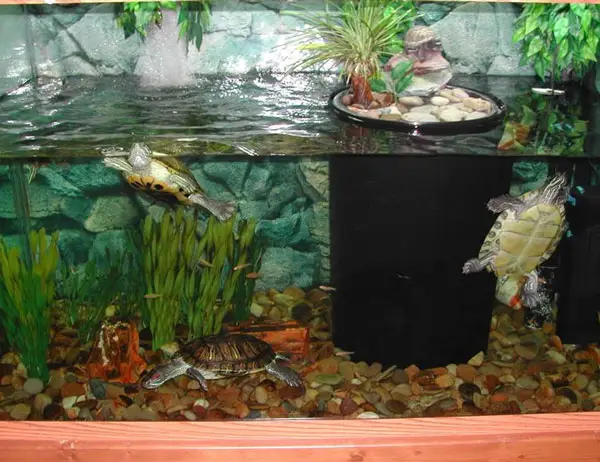
What’s more, mold can also be hazardous to other pets in your house. For instance, mold inhalation or digestion in dogs can lead to mold poisoning which can lead to respiratory issues like wheezing, sneezing, coughing, etc., or gastric issues such as stool changes, vomiting, etc.
Mold can also attach to your turtle shell and if the shell is damaged, the mold will easily find its way in and infect your turtle or even cause shell rot disease.
Also, mold in turtle tanks produces bad odors and can be unsightly to see. it tends to obstruct the view of your turtle tank, so it’s just not something fancy to have around.
Is it mold or algae?
If you see black streaks or patches in your aquarium, you may get confused as to whether it’s algae or mold. However, you can easily differentiate between the two by taking a closer look at them.
Algae is 100% harmless and more common than mold. It is a plant that requires sunlight to continue thriving.
Mold, on the other hand, doesn’t require sunlight for growth. It thrives in moist conditions (and the moisture must have organic material, which acts as the food for the fungi). Mold also prefers darker areas and will cease growth in well-lit areas
Another difference is that alga is much easier to remove. Mold is quite stubborn and can even prove costlier to get rid of.
Are there different kind of molds that form in a turtle tank?
Black and green mold are the most common types of mold that grow in a turtle tank. They’re known to thrive in moist and warm environments and the turtle tank provides just the excellent environment for them to thrive in
Black mold, in particular, appears due to leftover foods and increased phosphate levels in the water. This type of mold is a headache for many turtle owners.
This is because it tends to reaper which makes it challenging to completely get rid of. Nonetheless, it can still be removed by following the correct elimination methods we discussed earlier.
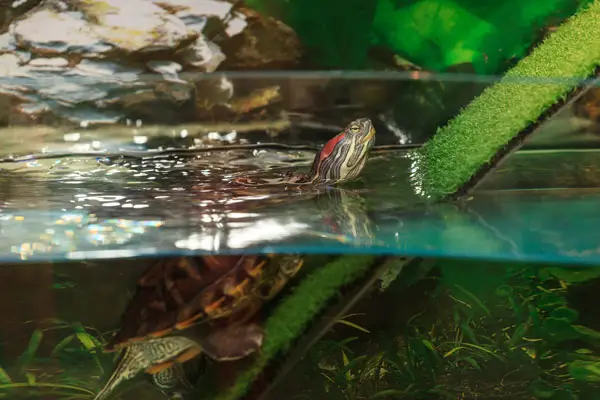
Green mold is likely to appear due to nutrient deficiency and poor tank water conditions in general. Providing your turtles with a balanced diet and keeping your tank clean can keep away this mold.
As for the white mold, it usually appears if you have substandard water in your turtle tank. If your turtle has an open wound, this fungus will also likely appear as it thrives in injuries as well as shell particles floating in the aquarium.
Related Questions:
A soft toothbrush can help you get rid of mold on your turtle shell. Brush the shell with the toothbrush moistened with water and a gentle soap and make sure you remove as much mold as possible. Afterward, rinse the shell and then dry it thoroughly.
Yes, turtles can grow mold if they live in poor tank conditions. The mold usually appears like gray patches of fuzzy white patches, usually on the shell. The fungus can sometimes attach to your turtle’s neck and legs.
Final Verdict
Mold is likely to occur in your turtle tank if you have dirty water. Nutrition imbalance caused by overfeeding or a less powerful filtration system will also cause mold to form in your tank. Introducing contaminated external objects into your tank will also cause mold to grow in your turtle where the environment is suitable, i.e. cool and moist.
Since mold can be hazardous to your turtles as well as humans and other pets in your home, we advise you to get rid of it as soon as possible. Keep in mind that letting it grow can also make it hard to remove. With the various removal and prevention methods we’ve shared with you in the above guide, we’re hopeful that you’re now ready to deal with mold in your turtle tank.
